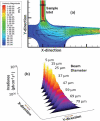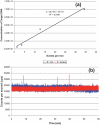Design and development of a field-deployable single-molecule detector (SMD) for the analysis of molecular markers
- PMID: 22005669
- PMCID: PMC3278993
- DOI: 10.1039/c1an15658f
Design and development of a field-deployable single-molecule detector (SMD) for the analysis of molecular markers
Abstract
Single-molecule detection (SMD) has demonstrated some attractive benefits for many types of biomolecular analyses including enhanced processing speed by eliminating processing steps, elimination of ensemble averaging and single-molecule sensitivity. However, it's wide spread use has been hampered by the complex instrumentation required for its implementation when using fluorescence as the readout modality. We report herein a simple and compact fluorescence single-molecule instrument that is straightforward to operate and consisted of fiber optics directly coupled to a microfluidic device. The integrated fiber optics served as waveguides to deliver the laser excitation light to the sample and collecting the resulting emission, simplifying the optical requirements associated with traditional SMD instruments by eliminating the need for optical alignment and simplification of the optical train. Additionally, the use of a vertical cavity surface emitting laser and a single photon avalanche diode serving as the excitation source and photon transducer, respectively, as well as a field programmable gate array (FPGA) integrated into the processing electronics assisted in reducing the instrument footprint. This small footprint SMD platform was tested using fluorescent microspheres and single AlexaFluor 660 molecules to determine the optimal operating parameters and system performance. As a demonstration of the utility of this instrument for biomolecular analyses, molecular beacons (MBs) were designed to probe bacterial cells for the gene encoding Gram-positive species. The ability to monitor biomarkers using this simple and portable instrument will have a number of important applications, such as strain-specific detection of pathogenic bacteria or the molecular diagnosis of diseases requiring rapid turn-around-times directly at the point-of-use.
This journal is © The Royal Society of Chemistry 2012
Figures







Similar articles
-
Development of dual-color total internal reflection fluorescence biosensor for simultaneous quantitation of two small molecules and their affinity constants with antibodies.Biosens Bioelectron. 2019 Feb 1;126:824-830. doi: 10.1016/j.bios.2018.12.010. Epub 2018 Dec 13. Biosens Bioelectron. 2019. PMID: 30602264
-
CCD based fiber-optic spectrometer detection.Methods Mol Biol. 2009;503:435-45. doi: 10.1007/978-1-60327-567-5_25. Methods Mol Biol. 2009. PMID: 19151957
-
Optical fiber-based fluorescent viscosity sensor.Opt Lett. 2006 Sep 1;31(17):2529-31. doi: 10.1364/ol.31.002529. Opt Lett. 2006. PMID: 16902608
-
Evanescent wave fluorescence biosensors.Biosens Bioelectron. 2005 Jun 15;20(12):2470-87. doi: 10.1016/j.bios.2004.10.026. Epub 2004 Dec 8. Biosens Bioelectron. 2005. PMID: 15854820 Review.
-
The potential use of fiber optics for detection in microchip separation and miniaturized flow-cell systems.J Capill Electrophor Microchip Technol. 2003 May-Aug;8(3-4):69-76. J Capill Electrophor Microchip Technol. 2003. PMID: 14596338 Review.
Cited by
-
A Point-of-Care Device for Molecular Diagnosis Based on CMOS SPAD Detectors with Integrated Microfluidics.Sensors (Basel). 2019 Jan 22;19(3):445. doi: 10.3390/s19030445. Sensors (Basel). 2019. PMID: 30678225 Free PMC article.
-
Lab-on-a-chip technologies for single-molecule studies.Lab Chip. 2013 Jun 21;13(12):2183-98. doi: 10.1039/c3lc90042h. Epub 2013 May 14. Lab Chip. 2013. PMID: 23670195 Free PMC article.
-
Single-pair fluorescence resonance energy transfer analysis of mRNA transcripts for highly sensitive gene expression profiling in near real time.Anal Chem. 2013 Aug 20;85(16):7851-8. doi: 10.1021/ac400729q. Epub 2013 Aug 5. Anal Chem. 2013. PMID: 23869556 Free PMC article.
-
fM to aM nucleic acid amplification for molecular diagnostics in a non-stick-coated metal microfluidic bioreactor.Sci Rep. 2014 Dec 5;4:7344. doi: 10.1038/srep07344. Sci Rep. 2014. PMID: 25475544 Free PMC article.
References
-
- Gell C, Sabir T, Westwood J, Rashid A, Smith DAM, Harris SA, Stockley PG. J. Mol. Biol. 2008;384:264–278. - PubMed
-
- Haupts U, Rudiger M, Ashman S, Turconi S, Bingham R, Wharton C, Hutchinson J, Carey C, Moore KJ, Pope AJ. J. Biomol. Screening. 2003;8:19–33. - PubMed
-
- Hintersteiner M, Auer M. In: Fluorescence Methods and Applications: Spectroscopy, Imaging, and Probes. Wolfbeis OS, editor. vol. 1130. 2008. pp. 1–11.
-
- Kang SH, Kim YJ, Yeung ES. Anal. Bioanal. Chem. 2007;387:2663–2671. - PubMed
-
- Moore KJ, Turconi S, Ashman S, Ruediger M, Haupts U, Emerick V, Pope AJ. J. Biomol. Screening. 1999;4:335–353. - PubMed
Publication types
MeSH terms
Substances
Grants and funding
LinkOut - more resources
Full Text Sources
Molecular Biology Databases
Research Materials

